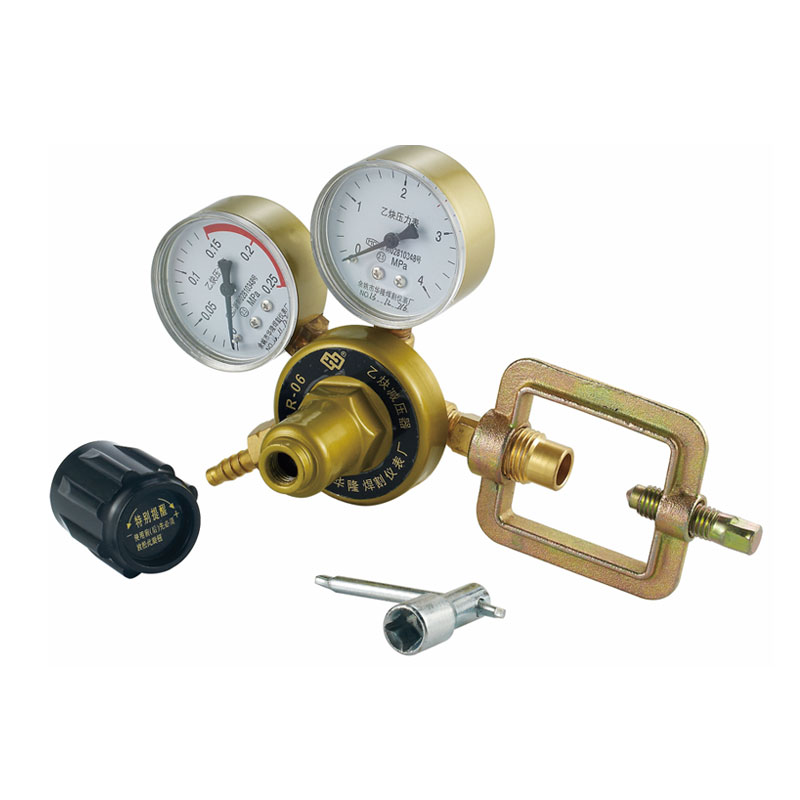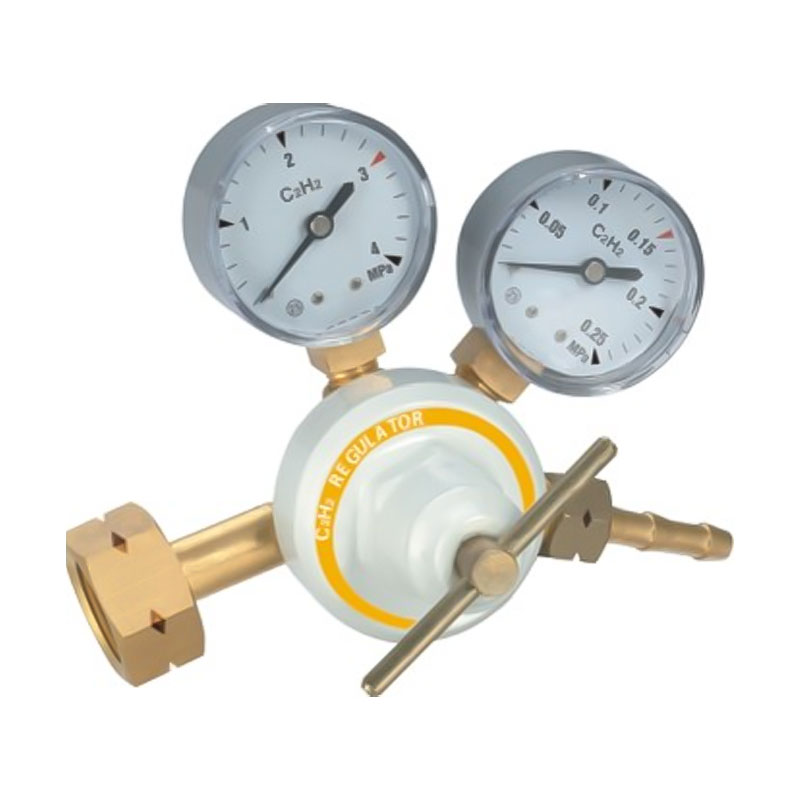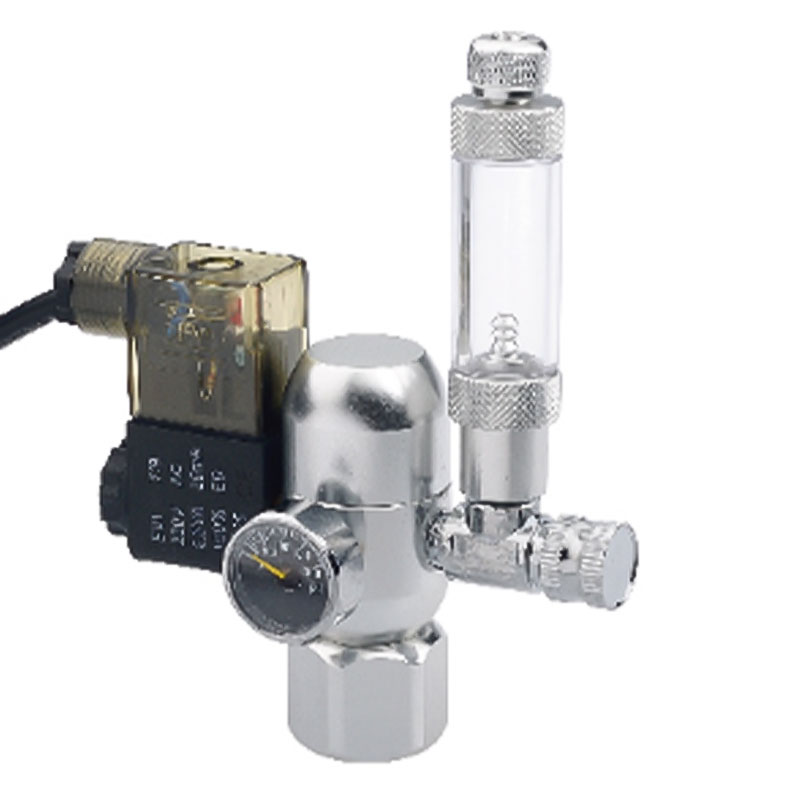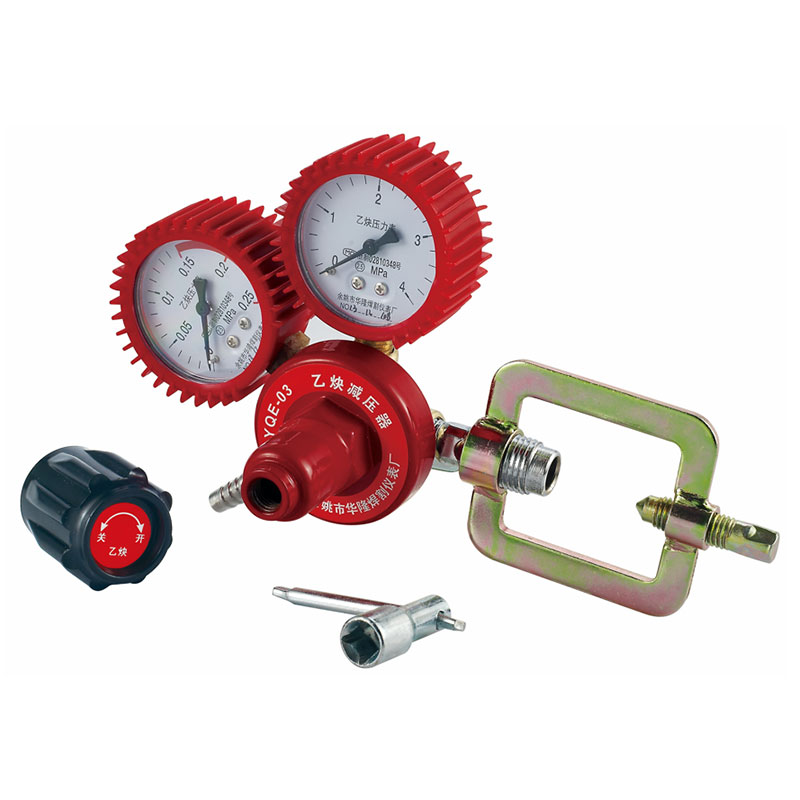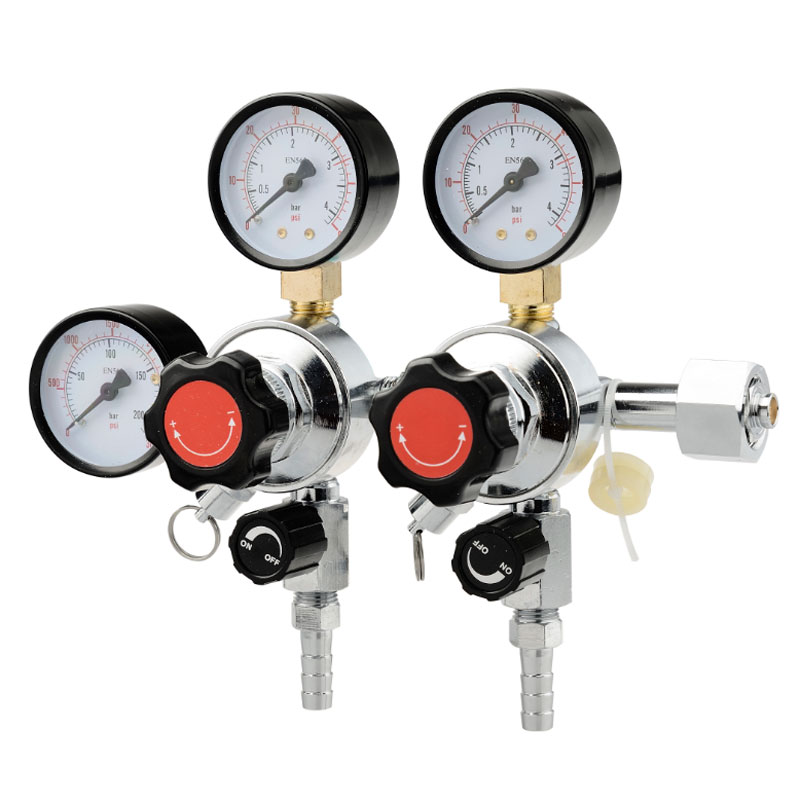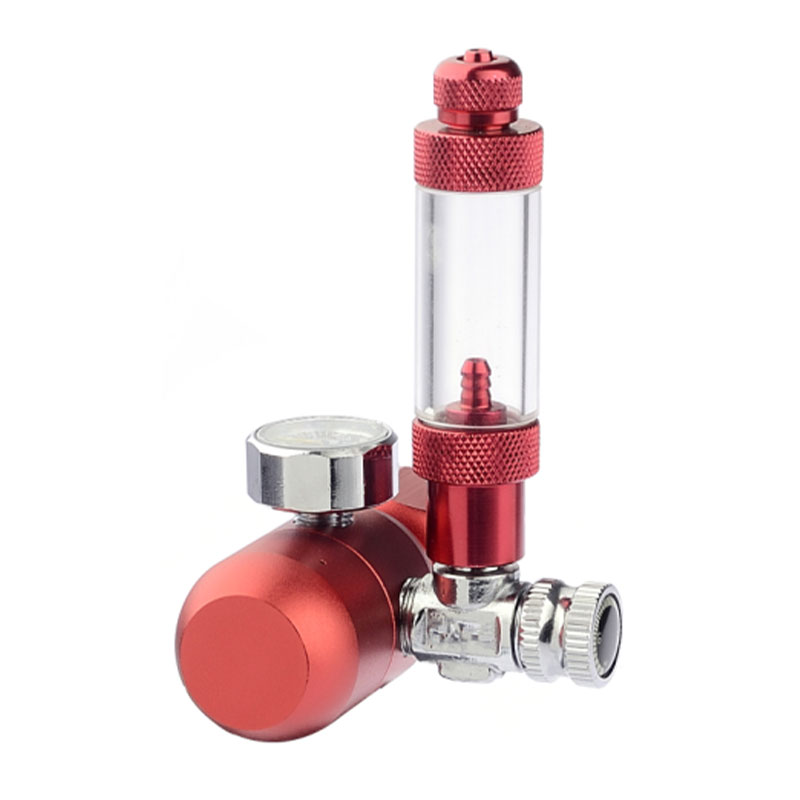AR-06 High-Performance Acetylene Regulator is designed as a pressure control device for industrial w...
See DetailsHow to Choose the Right Acetylene Pressure Regulator for Your Welding Setup
Industry News-What an Acetylene Pressure Regulator Does in a Welding System
The Acetylene Pressure Regulator plays a central and non-replaceable role within any oxy-fuel welding or cutting setup, controlling the transformation of high-pressure acetylene stored inside the cylinder into a safe, usable, and stable working pressure suitable for flame generation. To understand its place in a welding system, it is necessary to analyze in detail how acetylene behaves, why regulation is indispensable, how the regulator interacts with other system components, and how its internal mechanisms ensure consistent and safe fuel delivery. The following sections provide a highly technical and comprehensive explanation of these functions.
The Relationship Between Cylinder Pressure and Working Pressure in an Acetylene Welding System
Acetylene is stored in cylinders dissolved in acetone inside a porous filler mass, a unique storage method required to stabilize the otherwise highly unstable gas. Although the cylinder is labeled as 250 psi (around 1.7 MPa) when full, acetylene should never be withdrawn at pressures exceeding 15 psi (103 kPa) during welding or cutting operations. This creates a major gap between supply pressure and required output pressure, and the Acetylene Pressure Regulator serves as the intermediary that narrows this gap in a stable and controlled manner. Without a regulator, the torch would be exposed to cylinder pressure levels far beyond what the torch valves, hoses, and mixing chambers are designed to handle.
The regulator ensures that fluctuations in cylinder pressure—due to temperature, acetone absorption changes, or gas withdrawal rate—do not translate into sudden spikes in outlet pressure. By holding the outlet pressure at a consistent value, the regulator allows the welder to maintain a stable flame, which directly affects heat distribution, puddle control, penetration characteristics, and cut quality. Thus, the regulator is the critical device responsible for transforming a volatile, high-energy fuel source into a controllable stream suitable for industrial processes.
How the Acetylene Pressure Regulator Controls Fuel Flow to the Torch
The internal mechanics of an Acetylene Pressure Regulator are engineered to maintain precise outlet pressure through a balance of mechanical forces. Inside the regulator, the diaphragm, valve seat, spring, and adjusting screw work together as a synchronized system. When the adjusting screw compresses the spring, force is transmitted through the diaphragm, which opens the valve seat and allows high-pressure acetylene to enter the low-pressure chamber. As downstream pressure builds to match the spring tension, the diaphragm deflects and returns to equilibrium, which positions the valve seat so that flow stabilizes at the desired pressure.
This real-time self-balancing mechanism ensures that changes in torch demand—such as transitioning from pre-heating to full welding or cutting operation—do not cause abrupt pressure drops or surges. A regulator of poor quality may exhibit “creeping,” where the outlet pressure slowly rises even when the torch valves are closed. In acetylene systems, creeping is especially dangerous because excessive pressure can approach explosive thresholds. Therefore, the regulator’s ability to maintain stable pressure is not only about performance but also about preventing backfire, flashbacks, and fuel gas instability.
Interaction of the Acetylene Pressure Regulator With Hoses, Valves, and the Torch
Once acetylene exits the regulator at a controlled pressure, it travels through the fuel hose toward the torch body. The regulator determines the upstream pressure that the hose must handle and ensures that the hose remains within its rated working range. High-pressure acetylene could degrade hose materials, increase permeability, or create conditions conducive to reverse flow. Thus, the regulator protects every downstream component by ensuring pressure limitations are not exceeded.
Furthermore, the consistency of pressure delivered by the Acetylene Pressure Regulator directly impacts the performance of the torch mixing chamber. Acetylene must enter the torch at a stable pressure that matches the oxygen regulator’s output to maintain a correct fuel-oxygen ratio. If acetylene pressure fluctuates, the flame may shift from carburizing to oxidizing or momentarily extinguish, resulting in unstable cutting arcs, porous welds, or uneven heat distribution. Without proper regulation, the precision of oxy-fuel equipment becomes compromised, and the welder loses control over flame intensity, shape, and temperature.
The regulator also influences how the check valves and flashback arrestors function. These safety devices rely on pressure differentials to prevent reverse gas flow. If acetylene pressure is incorrectly regulated, a flashback arrestor may not activate properly, and backflow could occur through the torch or hoses. Thus, the regulator plays a critical upstream role in stabilizing the entire safety infrastructure of the welding system.
Preventing Hazardous Conditions Through Proper Pressure Regulation
Acetylene is chemically unstable above 15 psi and can decompose explosively even without oxygen when subjected to high pressure, heat, or shock. The Acetylene Pressure Regulator prevents the system from entering dangerous pressure levels by restricting outlet pressure to a safe working range. This makes the regulator one of the primary safety barriers in an oxy-fuel system.
Pressure control also prevents acetone entrainment. When an operator withdraws acetylene too quickly, liquid acetone may be pulled into the gas stream. This contaminates the torch, causes unstable flames, and damages hoses. By limiting pressure and regulating flow, the regulator reduces the likelihood of acetone carryover. High-quality regulators maintain controlled flow even when the cylinder approaches depletion, which ensures that the welder does not unknowingly withdraw fuel at unsafe rates.
In addition, the regulator prevents backfire conditions that may occur when the torch tip overheats or becomes obstructed. Stable acetylene pressure minimizes the risk of shockwaves propagating upstream. Excessive or unstable pressure can amplify backfire intensity, especially when combined with incorrect torch settings. By stabilizing pressure at the root of the system, the regulator mitigates these hazardous conditions before they can develop.
How the Acetylene Pressure Regulator Supports Flame Quality and Welding Efficiency
Flame quality is the core of oxy-fuel welding. Every welding or cutting operation—whether fusion welding, brazing, heating, or metal cutting—depends on a precisely balanced fuel-oxygen flame. The Acetylene Pressure Regulator is responsible for delivering acetylene at the exact pressure needed to create neutral flames for welding or carburizing flames for heating applications. Even slight deviations in pressure result in different flame characteristics, affecting temperature distribution, flame stability, and the shape of the inner cone.
As a result, the regulator directly influences weld bead formation, penetration consistency, and the torch’s ability to sustain continuous operation at high heat levels. For cutting applications, the regulator ensures that preheat flames remain steady so that metal reaches ignition temperature uniformly before oxygen jet activation. This reduces slag buildup, improves kerf smoothness, and allows for faster cutting speeds.
For heating operations, such as bending or loosening seized components, a stable flame prevents overheating and material damage. When pressure is stable, fuel consumption becomes more predictable, reducing operating costs and minimizing waste.
The Role of the Acetylene Pressure Regulator in Industrial and Heavy-Duty Welding Systems
Industrial systems often include larger torches, extended hose lengths, or multiple workstations connected to a single supply. These setups require robust regulators with higher flow capacity and greater resistance to pressure fluctuations. A heavy-duty Acetylene Pressure Regulator maintains consistent flow even when multiple operators withdraw fuel simultaneously or when long hoses increase downstream resistance.
In large-scale metal fabrication environments, precise regulation is critical for maintaining process repeatability. Equipment such as rosebud heating torches demand substantial acetylene flow, making regulator performance even more crucial. If the regulator cannot sustain adequate flow, flames may extinguish, causing operational delays or safety hazards. Conversely, regulators with excessive capacity may allow pressure spikes during idle periods. Industrial regulators are engineered to manage these variations through stronger springs, larger diaphragms, and more durable valve assemblies.
Why Internal Components of an Acetylene Pressure Regulator Matter in Welding Applications
The materials and internal construction of an acetylene regulator directly influence its performance. A high-quality diaphragm made of neoprene or reinforced elastomers responds quickly to pressure changes, providing smoother outlet pressure regulation. Precision-machined valve seats reduce turbulence and minimize wear, ensuring long-term stability of pressure output.
Springs within the regulator must deliver uniform tension that does not degrade under heat or repeated compression cycles. Inferior springs can weaken, causing inconsistent pressure output or slow response times. The regulator body, typically constructed from forged brass or plated alloys, must resist corrosion from acetone vapors and moisture. Internal filters trap particulate contamination from the cylinder valve, protecting the delicate valve and seat assemblies.
The regulator gauge accuracy also plays a significant role. Reliable high-pressure gauges help the operator evaluate cylinder content, while low-pressure gauges indicate output precision. Inaccurate gauges can mislead the welder into operating at unsafe pressures or inefficient settings. Thus, internal components of a regulator determine its suitability for different welding applications and influence overall system reliability.
Key Components to Look for in an Acetylene Pressure Regulator
An Acetylene Pressure Regulator is built from a collection of precisely engineered mechanical components designed to manage the transformation of high-pressure acetylene from the cylinder into a stable, controlled, and safe output pressure suitable for welding, cutting, brazing, and heating operations. Each internal and external element of the regulator contributes to its performance, durability, and safety. Understanding these components in depth allows welders, technicians, and industrial users to evaluate the quality of a regulator and select the correct model for their specific welding workflow. The following sections provide a highly technical and detailed explanation of the primary components that dictate how an acetylene regulator performs under real-world working conditions.
The Diaphragm and Its Influence on Pressure Stability
The diaphragm is one of the most important components of an Acetylene Pressure Regulator, acting as the flexible interface between the mechanical adjustment system and the gas control chamber. Its primary role is to respond to pressure differences on either side of its surface, moving in accordance with the spring tension and gas pressure to regulate the opening and closing of the valve seat. The material used for the diaphragm directly influences the regulator’s sensitivity, flexibility, and lifespan under varying temperature and pressure conditions.
Diaphragms in high-quality acetylene regulators are commonly made of neoprene or composite elastomers reinforced with fabric layers to maintain strength while preserving elasticity. The diaphragm must resist acetone vapors because acetylene cylinders contain acetone as a stabilizing medium. Exposure to acetone can degrade inferior diaphragm materials, reducing accuracy and risking premature failure. A diaphragm that becomes stiff or cracked may respond slowly or unevenly to pressure changes, causing the outlet pressure to fluctuate and producing inconsistent flame characteristics at the torch.
The diaphragm’s diameter also impacts regulator performance. Larger diaphragms can detect small changes in downstream pressure and provide smoother control, making them common in dual-stage and heavy-duty regulators. Smaller diaphragms respond more quickly but can be more prone to instability under high flow conditions. The mounting geometry, sealing integrity, and connection interface with the spring and valve assembly further influence how the diaphragm performs under dynamic welding conditions, where torch demand may vary rapidly.
The diaphragm’s operational sensitivity is crucial in preventing pressure creep, a dangerous condition in which outlet pressure slowly rises even when the torch valves are closed. High-quality diaphragms provide precise feedback to the mechanical components, ensuring that the regulator returns to equilibrium quickly and maintains stable pressure even when cylinder pressure fluctuates as the tank empties. For operators working with large rosebud heating tips or long hose runs, diaphragm performance becomes even more critical because the system demands greater flow stability.
The Valve Seat and Internal Valve Assembly
At the core of an Acetylene Pressure Regulator, the valve seat and the internal valve assembly control the actual flow path of acetylene entering the low-pressure chamber. The valve seat is typically made from a durable, gas-resistant material such as Teflon, brass, or a hardened alloy that maintains its sealing integrity under repeated cycles of opening and closing. The valve seat must form a perfectly tight seal to prevent unregulated gas flow from entering the low-pressure side.
Because acetylene is unstable under high pressure, the valve seat must operate with exceptional precision. Even minor imperfections in the seat surface or valve pin can lead to micro-leaks that cause creeping pressure increases. For this reason, regulators designed for industrial environments often incorporate finely machined valve seats with polished surfaces that reduce friction and wear. The geometry of the valve pin, including its taper, tip shape, and movement tolerance, also determines how smoothly the valve modulates flow.
The valve assembly is directly influenced by the diaphragm and spring mechanisms. When the adjusting screw increases spring tension, the diaphragm presses against the valve mechanism, lifting the valve pin off the seat and allowing high-pressure acetylene to pass into the regulator body. As downstream pressure increases, the diaphragm deflects back, allowing the valve seat to close partially or fully. This constant modulation requires the valve components to be highly resistant to wear, corrosion, and particulate contamination.
Internal filters are commonly placed upstream of the valve seat to prevent solid contaminants from reaching the precision-machined areas. A damaged or contaminated valve seat can lead to unstable output pressure, backflow issues, or gas leaks. In heavy-duty welding environments, where airborne particulates or contaminated cylinders are more common, a regulator with a robust valve assembly and advanced filtering design offers significantly greater reliability.
The Adjusting Screw and Spring Mechanism
The adjusting screw is the user’s direct interface with the internal control mechanism of an Acetylene Pressure Regulator. When the operator turns the adjusting screw clockwise, it compresses the main control spring, increasing tension on the diaphragm and allowing the valve seat to open wider. Turning the screw counterclockwise reduces spring tension, allowing the gas pressure to push the diaphragm backward and close the valve seat to reduce outlet pressure.
The quality of the adjusting screw influences how smoothly and precisely the operator can control the regulator. A finely threaded screw allows for micro-adjustments, which is important when setting low acetylene pressures for fine welding operations or delicate brazing tasks. Coarse threads may feel loose or imprecise, making it difficult to set exact outlet pressure values. Heavy-duty industrial regulators often incorporate recessed or shrouded adjustment screws to protect against accidental contact, impact, or environmental contamination.
The spring paired with the adjusting screw must be engineered for long-term stability. Springs are typically manufactured from heat-treated steel alloys designed to maintain consistent tension despite thousands of compression cycles. A weak or fatigued spring can cause inconsistent pressure output, delayed response time, or abrupt pressure loss during welding. The spring’s stiffness rating determines the regulator’s pressure range, making precise calibration during manufacturing essential. Regulators intended for heavy-duty applications may use stronger springs to handle higher flow demand while maintaining consistent outlet pressure at all torch settings.
Spring performance is especially important for acetylene because of the strict 15 psi limit required for safe operation. If the spring does not maintain predictable behavior across its full adjustment range, the regulator may allow acetylene pressure to rise beyond safe levels. As a result, high-quality regulators incorporate springs with tight manufacturing tolerances and specialized coatings that protect against corrosion from moisture or acetone vapors.
Pressure Gauges and Their Role in Monitoring System Performance
Pressure gauges mounted on an Acetylene Pressure Regulator provide critical real-time information about cylinder contents and outlet pressure. The high-pressure gauge allows the operator to monitor remaining acetylene, which is important for maintaining stable flame performance and avoiding rapid withdrawal as the cylinder nears depletion. The low-pressure gauge displays the regulated output pressure delivered to the torch.
Gauge accuracy directly affects operational safety and flame quality. High-quality regulators use gauges with precise calibration and clear, easy-to-read markings that allow fine pressure adjustments, especially when working with delicate torch settings. The gauge housings must be durable enough to resist vibration, heat, and impact, and sealed against contaminants that could fog the lens or interfere with movement of the internal mechanism.
Because acetylene systems operate at relatively low outlet pressures, even small deviations in gauge accuracy can affect flame characteristics. For example, a gauge that reads slightly lower than the actual pressure may cause the operator to inadvertently exceed safe pressure limits. Gauge reliability becomes even more important in industrial environments where torches may be operated for extended periods and pressure changes can affect cut quality, weld penetration, or heating efficiency.
The Regulator Body and Structural Materials
The regulator body houses all internal mechanisms and serves as the primary pressure-containing component of an Acetylene Pressure Regulator. The body must withstand high cylinder pressures, exposure to acetone vapors, vibration from nearby equipment, and physical impacts in industrial settings. Forged brass is the most common material due to its corrosion resistance, machinability, and proven reliability in gas regulation equipment.
The internal design of the regulator body includes separate high-pressure and low-pressure chambers, precisely machined to guide acetylene flow and ensure stable pressure transitions. The thickness of the walls, quality of the threads, and surface finish inside the chambers all influence the regulator’s ability to maintain consistent performance. Regulators built from thin or low-quality cast materials may warp or crack under pressure, creating leak paths or instability.
Regulator bodies may also incorporate cooling fins or heat-dissipating shapes to mitigate temperature rise during high-flow operations. Although acetylene systems typically operate at lower pressure than oxygen systems, rapid flow can still cause temperature fluctuations that affect regulator response. A robust body design helps maintain mechanical stability, supporting smoother operation of the diaphragm, spring, and valve assembly.
Inlet and Outlet Connections and Their Compatibility
The inlet connection of an Acetylene Pressure Regulator must match the cylinder valve’s thread type and adhere to national or regional gas safety standards. Acetylene cylinders typically use left-hand threaded connections to prevent accidental interchange with oxygen or inert gas equipment. The sealing surfaces must be precisely machined to ensure leak-free operation under high pressure.
The outlet connection directs regulated acetylene to the hose leading to the torch. The outlet must maintain structural integrity even when hoses move during welding or when torches undergo frequent repositioning. Regulators used in industrial fabrication shops often incorporate reinforced outlet connections designed to withstand repeated torque, vibration, and stress from heavy hoses.
Thread compatibility and sealing performance are crucial for safety. Any leak on the high-pressure inlet interface exposes the operator to explosive acetylene discharge. Poor outlet connections can allow gas leakage that affects flame consistency or ignites near ignition sources. High-quality regulators incorporate precision-machined connections with reliable sealing mechanisms to maintain safe, stable operation.
How to Match an Acetylene Pressure Regulator to Your Welding Applications
Matching an Acetylene Pressure Regulator to specific welding, cutting, brazing, or heating operations requires a deep understanding of gas flow demands, pressure characteristics, torch specifications, hose length, cylinder types, and the overall working environment. Different welding applications require different flow rates, output pressures, regulator materials, and design features to maintain safe and stable performance. Acetylene is chemically sensitive, prone to decomposition at elevated pressures, and dependent on acetone stability inside the cylinder, making the choice of regulator even more critical. Selecting an improper regulator can lead to unstable flame conditions, reduced torch efficiency, increased acetone carryover, poor weld quality, or hazardous pressure spikes. The sections below examine, in high technical detail, how to match an acetylene regulator to different welding applications by analyzing system demands, regulator capabilities, and operating constraints.
Assessing Gas Flow Requirements for Different Welding and Cutting Tasks
Each welding process imposes a different demand on the flow capacity of an Acetylene Pressure Regulator, and understanding these requirements is fundamental before selecting the appropriate regulator model. Small-scale welding operations that use lightweight torches and small tips, such as jewelry soldering or fine brazing, require very low flow rates and minimal outlet pressure. These tasks depend on regulators capable of precise low-pressure adjustments with minimal fluctuation. A regulator designed for high-flow industrial tasks may lack the fine control needed for such delicate work, because the spring tension, valve geometry, and diaphragm sensitivity are often optimized for higher flow ranges. Therefore, low-capacity regulators with finely threaded adjusting screws and highly sensitive diaphragms are typically more suitable for precision applications.
For common oxy-acetylene welding tasks in fabrication shops, moderate flow regulators are required. Welding tips used for joining mild steel often demand consistent and steady flow but not at the extremely high levels associated with cutting or heating. Regulators used for general welding must provide stable pressures across mid-range flow demands without drifting as the torch cycles on and off. In these applications, a regulator with a durable diaphragm and moderate spring tension performs well, allowing operators to maintain a neutral flame necessary for clean weld puddle formation.
Cutting torches and rosebud heating tips present the highest demands on acetylene flow capacity. Because acetylene withdrawal is restricted to prevent acetone entrainment and decomposition risks, the regulator must handle large flows efficiently without causing excessive withdrawal rates from the cylinder. Heavy-duty regulators incorporate enlarged orifices, heavier springs, and reinforced valve components to maintain stable flow under heavy load. Without sufficient regulator flow capacity, flames may repeatedly extinguish, pressure may fluctuate dangerously, and the torch may fail to reach proper heating temperatures. Matching flow capacity to task demands is essential to prevent unnecessary strain on the regulator and ensure that flame characteristics remain stable even during peak usage.
Determining Appropriate Outlet Pressure for Specific Torch Types
Different torch types and tip sizes require specific acetylene outlet pressure ranges, making it essential to choose an Acetylene Pressure Regulator that can reliably control pressure within the recommended limits. Lightweight welding torches often require low pressure settings around 3–5 psi. If the regulator is incapable of providing precise control at low output levels, flame instability may occur, resulting in backfires, uneven heat distribution, or difficulty maintaining a stable inner cone. Low-pressure precision requires regulators equipped with finely tuned springs and diaphragms capable of responding quickly to minor pressure shifts.
For medium-duty and general-purpose torches, the typical working pressures range between 5–10 psi depending on tip size and flame requirements. Regulators used for this range must maintain pressure stability even when the operator adjusts oxygen settings, changes tip sizes, or modifies torch angles. Pressure fluctuation can cause the flame to shift from neutral to carburizing or oxidizing, which affects weld penetration, slag formation, and the overall quality of the cut or weld. A regulator that can hold mid-range pressure with minimal deviation under fluctuating flow conditions is crucial for consistent daily operation.
For heating tips and cutting torches, the pressure must remain low enough to comply with acetylene safety limitations yet stable enough to support large flames. Although acetylene cannot safely exceed 15 psi outlet pressure, large torches often demand pressures close to the upper safe limit. Regulators in this range must incorporate safety mechanisms to prevent accidental over-pressurization while still supporting high-flow requirements. The combination of pressure limits and flow demands makes the regulator’s internal construction—such as spring stiffness, diaphragm diameter, and valve seat geometry—especially important.
Matching Regulator Capacity to Torch Size and Heat Output Needs
Torch size, tip number, and expected heat output are direct determinants of the regulator capacity required for a given application. A small welding torch designed for sheet metal work requires minimal acetylene flow and relies on the regulator for steady, low-pressure delivery. A high-capacity regulator may supply more gas than needed, making precise control difficult. The mismatch between torch requirements and regulator design may also result in erratic flame behavior when the torch valves are adjusted.
Conversely, using a low-capacity regulator with a large rosebud heating tip or a heavy-duty cutting torch results in severe performance deficiencies. Large heating tips require constant high-volume fuel flow to maintain stable combustion, and a regulator that cannot meet this demand may cause repeated flameouts, noisy torch operation, or inconsistent preheat temperatures. A regulator with insufficient capacity also increases the likelihood of acetone draw from the cylinder because the operator may inadvertently increase pressure in an attempt to compensate for inadequate flow. Matching regulator flow capacity to torch demands helps prevent torch overheating, metal distortion, and poor cutting or weld quality.
In production environments where torches operate continuously or multiple operators rely on the same supply source, regulators with high-flow ratings and reinforced internal components are essential. The regulator must accommodate sustained demand without pressure cycling or fatigue in internal structures. Additionally, the regulator body must maintain structural stability under prolonged high-flow conditions, which often produce temperature fluctuations that impact internal sealing surfaces. Ensuring that regulator capacity aligns with torch and application demands improves overall system efficiency and minimizes risk.
Considering Hose Length and System Configuration
Hose length and configuration play an important role in determining the performance required from an Acetylene Pressure Regulator. Longer hoses introduce resistance to gas flow, resulting in pressure drops that may affect torch performance. A regulator must compensate for these drops by maintaining stable outlet pressure despite increased downstream resistance. In environments where operators work at varying distances from the cylinder, particularly in automotive repair shops or large fabrication facilities, a regulator capable of handling extended hose runs without sacrificing pressure stability is essential.
Bends, couplings, and hose age also influence flow characteristics. Older hoses may have internal roughness or partial obstruction that increases resistance, requiring the regulator to deliver more consistent output pressure. When multiple hoses or manifolds are used to distribute acetylene to several workstations, the regulator must supply adequate flow without triggering unstable pressure fluctuations across the system. Industrial-grade regulators with larger diaphragms, chambers, and orifice sizes are typically better suited for complex hose configurations.
Mobile or field operations introduce additional variables. Equipment vibration, frequent cylinder movement, and fluctuating temperatures can affect regulator performance. Regulators selected for field use often include shock-resistant features, reinforced gauges, and robust inlet/outlet connections to ensure stable operation even under adverse working conditions. Matching regulator capabilities to hose configuration and mobility requirements ensures consistent pressure delivery regardless of layout or environmental changes.
Selecting Regulators Based on Cylinder Size and Withdrawal Rate Limitations
Acetylene cylinders vary in size, and the safe withdrawal rate from each cylinder type affects regulator selection. Larger cylinders allow higher withdrawal rates without risking acetone entrainment, while smaller cylinders require more controlled flow. The Acetylene Pressure Regulator must be capable of maintaining stable output without exceeding the withdrawal limits of the cylinder. Operators who use large cutting tips or heating equipment must select regulators that pair effectively with cylinders of sufficient capacity. Using high-flow regulators with small cylinders can lead to excessive acetone withdrawal, contaminated flame characteristics, and unstable torch performance.
Industrial settings where multiple torches are supplied from a large bank of cylinders require regulators with high inlet pressure tolerance and stable multi-directional flow control. Regulators in these systems must withstand pressure variations caused by multiple operators adjusting their torch settings simultaneously. The regulator’s internal components must be capable of handling repeated cycles of pressure change without fatigue or performance drift.
Cylinder temperature also affects acetylene pressure. In cold environments, cylinder pressure may drop significantly, requiring a regulator with sensitivity capable of maintaining consistent outlet pressure despite reduced inlet pressure. Heavy-duty regulators designed with large diaphragms and reinforced springs handle low-temperature conditions more effectively, preventing flame instability that may arise from fluctuating fuel supply characteristics.
Differences Between Single-Stage and Dual-Stage Acetylene Pressure Regulator Designs
The structural and operational differences between single-stage and dual-stage Acetylene Pressure Regulator designs determine how each type controls pressure, responds to cylinder depletion, manages flow fluctuations, handles torch load changes, and maintains flame stability under various working conditions. Because acetylene is chemically sensitive and must be controlled within narrow safety parameters, the distinction between these two regulator designs is especially critical in welding, cutting, heating, and industrial metalworking applications. Both regulator types perform the essential task of reducing high cylinder pressure to a usable outlet pressure, but the internal mechanisms, application suitability, and performance characteristics differ substantially. Understanding these differences requires an extensive examination of their internal design architecture, mechanical response behavior, pressure stability characteristics, safety implications, and specific suitability for different workflows.
Functional Operation of a Single-Stage Acetylene Pressure Regulator
A single-stage Acetylene Pressure Regulator reduces cylinder pressure to working pressure in one mechanical step. As gas enters the regulator from the acetylene cylinder, the high-pressure chamber receives incoming pressure and feeds it to the diaphragm-controlled valve seat. The diaphragm, acting against spring tension, modulates the opening of the valve to produce an immediate pressure drop to the set outlet pressure. Because this process occurs in a single phase, the outlet pressure is heavily influenced by fluctuations in cylinder pressure, torch demand, temperature variations, and changes in the position of the adjusting screw.
Single-stage regulators have fewer internal components, including one main diaphragm, one valve seat, one control spring, and a single low-pressure chamber. Their simpler configuration makes them more affordable and easier to maintain, but also more susceptible to instability. As the cylinder empties and inlet pressure drops, the outlet pressure tends to drift upward unless manually corrected by the operator. This drift occurs due to the mechanical relationship between decreasing inlet pressure and spring-diaphragm equilibrium shift. The operator must adjust the regulator periodically to maintain correct pressure for the torch, especially during long weld runs or when performing extended cutting operations.
Torch demand dramatically affects single-stage regulator stability. When the torch is ignited or shut off, or when the operator changes tip size or flame settings, the sudden change in downstream resistance can cause temporary pressure spikes or drops. These fluctuations are especially noticeable when using large cutting tips or heating torches that draw high acetylene volume. Even small fluctuations can affect flame characteristics, causing the inner cone to elongate or shrink, producing uneven heat patterns that compromise weld penetration or cut quality.
The sensitivity of single-stage regulators to environmental changes also impacts performance. Temperature shifts affect spring tension and diaphragm elasticity, which can alter regulator output. In a cold shop environment, the diaphragm stiffens slightly, slowing its response to pressure fluctuations. In hot industrial facilities, a softened diaphragm and weakened spring force can contribute to pressure creep. These factors, combined with the inherent design characteristics of single-stage regulators, make them more suitable for light-duty or intermittent welding operations rather than continuous industrial use.
Functional Operation of a Dual-Stage Acetylene Pressure Regulator
A dual-stage Acetylene Pressure Regulator reduces pressure in two separate mechanical steps, providing significantly greater outlet stability and minimizing the influence of cylinder depletion or torch load variation. The first stage reduces the inlet pressure to an intermediate level, while the second stage further refines the pressure to the operator’s selected working level. Each stage includes its own diaphragm, valve assembly, and control mechanism, resulting in superior control over outlet pressure and substantial improvement in flame consistency.
In the first stage, high inlet pressure enters the regulator and is reduced to a moderately low and stable intermediate pressure. This pressure is not directly adjustable by the operator but is engineered to remain consistent regardless of cylinder pressure decline. The second stage receives this intermediate pressure and further modulates it through a second diaphragm and valve seat system, delivering an exceptionally stable and precise outlet pressure. Because the intermediate stage absorbs the majority of pressure fluctuations, the second stage can focus solely on fine pressure control, resulting in minimal drift during cylinder depletion.
Dual-stage regulators excel in applications where long torch operation is required. Their ability to maintain stable pressure ensures that flame characteristics remain constant during extended welding or cutting processes. When using large rosebud heating tips or high-capacity cutting torches, the dual-stage design responds smoothly to changes in flow demand without producing sudden output pressure changes. This stability is essential for industrial environments where weld consistency, cut precision, and process repeatability must be maintained.
Dual-stage regulators also support greater operational safety due to their reduced tendency toward pressure creep. The presence of two valve stages creates a fail-safe effect in which any minor leak past the first stage is absorbed or minimized by the second stage. This design minimizes the risk of acetylene outlet pressure rising above safe limits. Additionally, dual-stage regulators are more resistant to environmental fluctuations because each stage isolates thermal and pressure variations. Temperature changes affect each diaphragm and spring independently, and their combined effect tends to average out, creating more stable performance.
Differences in Internal Structure and Mechanical Response
The most significant structural difference between the two regulator types is the number of diaphragms, valve assemblies, and pressure chambers. A single-stage regulator contains one diaphragm interacting with a single valve seat. This design is mechanically simple and inherently more reactive to inlet pressure variations. When the cylinder pressure drops as acetylene is consumed, the changing force differential affects the diaphragm’s equilibrium point, which manifests as an increase in outlet pressure unless corrected. The single-stage regulator’s response curve is therefore closely tied to inlet pressure.
A dual-stage regulator contains two diaphragms and two valve seats, arranged in sequence. The first stage reduces cylinder pressure to an intermediate constant level, effectively isolating the second stage from inlet pressure fluctuations. This isolation produces a much flatter response curve across the entire cylinder lifespan. Because the second stage receives stable intermediate pressure, its output remains consistent even when cylinder pressure drops significantly. The dual mechanical layers provide redundancy and improved proportional response behavior.
The valve seats in dual-stage regulators experience less wear because each valve handles lower differential pressure. In contrast, the valve seat in a single-stage regulator must handle the full cylinder pressure at all times, which increases wear rate and may lead to earlier performance degradation. The mechanical load on the diaphragm also differs significantly. Single-stage diaphragms must balance large pressure differences and therefore must be larger and thicker, potentially reducing sensitivity. Dual-stage diaphragms operate within narrower pressure zones, enabling finer control using thinner, more responsive materials.
Performance Differences Under Varying Torch Load Conditions
Torch load conditions—defined by tip size, flame setting, and flow demand—significantly affect regulator performance. Single-stage regulators respond more dramatically to load changes because they must adjust flow in real time based solely on diaphragm movement. When a torch transitions from idle to full flame or when an operator triggers the cutting oxygen lever, the sudden change in flow affects downstream pressure. The single-stage regulator often reacts with temporary output pressure overshoot or drop until equilibrium is reestablished.
Dual-stage regulators manage load changes much more smoothly. Because the first stage provides a stable intermediate buffer, the second stage reacts to flow disturbances with significantly less pressure variation. This stability is crucial for industrial torches that require consistent flames for long-duration cutting or heating tasks. When using large tips that demand high flow, the dual-stage regulator maintains pressure with minimal fluctuation, improving preheat performance and cut uniformity.
Heavy-duty heating operations emphasize the performance gap further. A rosebud heating torch may require rapid pressure adjustments as metal temperature changes or as the operator adjusts distance from the workpiece. Single-stage regulators struggle with this dynamic load because they must manage both pressure reduction and modulation simultaneously. Dual-stage regulators distribute these responsibilities across two mechanical stages, resulting in steadier flow, reduced pressure wave propagation, and improved torch stability.
Application Suitability and Use-Case Selection Criteria
Single-stage regulators are generally suitable for light-duty or intermittent welding tasks where precision is less critical and torch load is moderate. They are commonly used for small welding jobs, thin material brazing, minor repairs, and hobbyist applications. Cost-conscious environments also favor single-stage regulators due to their affordability and simpler maintenance requirements.
Dual-stage regulators are preferred in professional welding, industrial fabrication, heavy cutting, heating, and any application where long-duration flame stability is essential. Operators who rely on precise control, consistent heat distribution, and stable performance across entire cylinder lifespans benefit significantly from dual-stage designs. Environments that require process repeatability, such as production welding or manufacturing lines, rely on dual-stage regulators to maintain flame uniformity across shifts and tasks.
Dual-stage regulators are especially preferred when using large tips, high-flow torches, long hoses, or manifold systems supplying multiple stations. Their ability to maintain stability under fluctuating load conditions and changing inlet pressures makes them indispensable in high-demand environments.


 English
English  русский
русский  Español
Español 